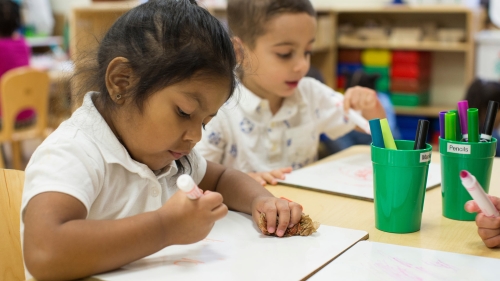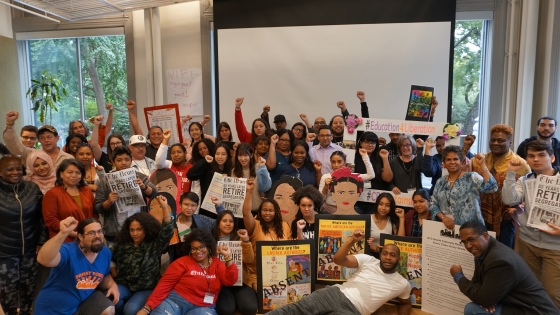The Need
In the current political environment, when the prevalence of racism and other biases are on sharp display across the country, cities must take a hard look at how public schools either perpetuate or confront these forces. Research shows that racial bias, and its many layers of impact, is widespread across every aspect of the public school experience:
- High school teachers expect 58% of White high school students, but just 37% of Black high school students, to graduate from college. White teachers were 9 percentage points less likely than their black colleagues to expect that the same student would earn a college degree.[i]
- White middle school math teachers are three times more negative regarding Black students’ emotions and ability compared to white students [ii]
- School staff frequently perceive Black boys as threatening and dangerous for the same behaviors that are seen as innocent for White students.[iii]
- There are significant disparities and stereotypes in how teachers communicate with parents from different racial, ethnic and immigrant backgrounds.[iv]
- Implicit and overt bias are common in schools and drive disparities in engagement and outcomes [v]
- Black and Latino teachers leave teaching at faster rates than their White peers, due to limitations on professional advancement and stagnation in disciplinary and remedial roles [vi]
- In 2015, only 15% of children’s books were written by African-American or Latino authors, or focused on African-American or Latino characters [vii]
- In a national survey of public school teachers, there was broad agreement that race should be discussed in classrooms, but teachers felt unprepared and unable to lead those conversations. [viii]
- In NYC, 85% of the students are of color, and 60% of teachers are white. There are 266 schools with 0 or 1 Latino teacher, 327 with 0 or 1 Black teacher, and 690 with 0 or 1 Asian teacher [ix]

This reality creates a culture gap between students and the educational system that contributes to student disengagement from school, and to the academic achievement gap. The Connecticut State Department of Education describes this culture gap, and the solution:
... one of the key factors influencing poor student achievement among students of color is the cultural incongruity between the school and the home. This combined with a further cultural mismatch between teaching styles and curriculum, and that of the culture and learning styles of students of color, leads to a failure to engage students effectively. Culturally responsive education is a teaching approach that helps students use their cultural backgrounds to aid in the acquisition of knowledge, skills and attitudes. Culturally responsive teachers use culturally relevant instructional material, affirm student cultural identities, and use cultural backgrounds as a knowledge base for learning and academic success. While helping to close the achievement/opportunity gaps, culturally responsive education also helps fight racism and other forms of discrimination, bias and oppression. [x]
The Solution
In today’s society, schools must fortify students against hateful and oppressive messages, and arm them with a deep knowledge and pride in who they are. Schools can do this by adopting culturally responsive education and becoming safe havens from racism, xenophobia, Islamophobia, homophobia and other biases. Research evidences the success of culturally responsive policies, and many schools, districts and communities are developing their own solutions:
- Research shows that having at least one Black teacher between 3rd and 5th grades reduces a Black student’s probability of dropping out by 29% [xi]
- Programs that develop positive feelings about Blackness among African-American girls contribute to greater academic motivation, curiosity, persistence and achievement [xii]
- Students who report receiving culturally relevant teaching, also report more positive academic outcomes and positive racial identity development [xiii]
- Individuals who receive research-based, high-quality training in bias, power, and privilege, show reduced bias, increased empathy and more culturally responsive behaviors in the classroom [xiv]
- An elementary school in Alaska greatly increased math achievement for Native American students and all students by connecting math concepts with traditional cultural activities such as basket making, fire building, star navigating, fishing, collecting food, weaving, etc. [xv]
- New York City public schools now require every single school and district employee to attend at least a one-day training on implicit bias. Superintendents, principals and other leadership attend several days of training and receive ongoing support from a central office of CRE experts.
- Cambridge Street Upper School in Massachusetts builds teachers’ capacity by holding weekly small group discussions about race. Teachers examine their upbringing and biases, develop comfort and skill talking about race, and build supportive relationships with their peers around the issue [xvi]
- Parents in the Bronx built collaborations with school staff by leading yearly neighborhood tours, to teach about historic community sites, meet local leaders and learn about students’ culture
- At Highbridge Green School in the Bronx, parents and teachers co-wrote a culturally responsive unit in which Latinx students read testimonies of immigrant experiences, interviewed their parents, and visited Chinatown to connect with the experiences of other immigrant group. [xvii]

The Impact
In Tucson, AZ in the early 2000s, all students were offered the opportunity to participate in a Mexican- American Studies curriculum that was academically rigorous and aligned with state standards.xviii Research from 2010 showed that participating students had improved test scores in Math, Reading and Writing and were more likely to graduate from high school. Low-income students and academically struggling students showed the largest gains.xix Students were more engaged in literature and history lessons, and more likely to have a positive perception of their ability to succeed in math and science. [xx]
In 2010, the San Francisco Unified School District implemented an Ethnic Studies program for 9thgraders. A 2016 research study found that over four years, this program produced improvements in academic performance for students who were in jeopardy of failing. Because of the Ethnic Studies program, 9th grade student attendance increased by 21 percentage points, GPA increased by 1.4 grade points, and earned credits increased by 23 credits. [xxi]
References
[i] http://research.upjohn.org/cgi/viewcontent.cgi?article=1248&context=up_workingpapers ; http://educationnext.org/power-of-teacher- expectations-racial-bias-hinders-student-attainment/
[ii] http://www.dailytargum.com/article/2019/02/white-teachers-three-times-more-negative-with-black-students-rutgers-study-finds
[iii] http://www.apa.org/news/press/releases/2014/03/black-boys-older.aspx
[iv] https://www.theatlantic.com/education/archive/2016/11/which-parents-are-teachers-most-likely-to-contact/507755/
[v] https://www.sciencedirect.com/science/article/pii/S0049089X16307098; https://www.brookings.edu/blog/brown-center- chalkboard/2017/03/20/the-insidiousness-of-unconscious-bias-in-schools/
[vi] https://nces.ed.gov/pubs2014/2014077.pdf and https://edtrust.org/wp-content/uploads/2014/09/ThroughOurEyes.pdf
[vii] http://ccbc.education.wisc.edu/books/pcstats.asp
[viii] https://www.theatlantic.com/education/archive/2017/01/how-teachers-learn-to-discuss-racism/512474/
[ix] http://www.ibo.nyc.ny.us/iboreports/2014teacherdemographics.pdf and https://newyork.edtrust.org/resource/educator-diversity-new-york- city/
[x] Connecticut State Department of Education: http://www.sde.ct.gov/sde/lib/sde/pdf/curriculum/cali/cre_handbook.pdf
[xi] http://releases.jhu.edu/2017/04/05/with-just-one-black-teacher-black-students-more-likely-to-graduate/
[xii] https://www.jbhe.com/2018/01/study-shows-strong-racial-identity-improves-academic-peformance-of-young-black-women/
[xiii] https://journals.sagepub.com/doi/10.1177/2158244016660744
[xiv] https://www.ncbi.nlm.nih.gov/pmc/articles/PMC3603687/; https://link.springer.com/article/10.1007/s10869-012-9264- 7https://www.ncbi.nlm.nih.gov/pubmed/25374039; https://www.pnas.org/content/early/2016/04/20/1523698113; http://www.sciencemag.org/news/2016/04/reduce-student-suspensions-teachers-should-try-being-more-empathetic
[xv] Kisker, Ellen Eliason, Jerry Lipka, Barbara L. Adams, Anthony Rickard, Dora Andrew-Ihrke, Eva Evelyn Yanez, and Ann Millard. "The Potential of a Culturally Based Supplemental Mathematics Curriculum to Improve the Mathematics Performance of Alaska Native and Other Students." Journal for Research in Mathematics Education 43.1 (2012): 75. Web. 17 Jan. 2017.
[xvi] Cummings, Jean. "Upper school tackles race head on, weekly, with intense cultural proficiency initiative." Cambridge Day. N.p., 25 May 2016. Web. 07 Jan. 2017.
[xvii] http://www.chalkbeat.org/posts/ny/2014/04/07/highbridge-green-school-students-present-a-project-their-parents-helped-design/
[xviii] Cabrera, N. L., Milem, J. F., Jaquette, O., & Marx, R. W. (2014). Missing the (Student Achievement) Forest for All the (Political) Trees: Empiricism and the Mexican American Studies Controversy in Tucson. American Educational Research Journal, 51(6), 1084-1118.
[xix] Cabrera et al., 2014
[xx] http://www.huffingtonpost.com/2014/12/01/mexican-american-studies-student-achievement_n_6249592.html?1421108833
[xxi] http://news.stanford.edu/2016/01/12/ethnic-studies-benefits-011216/

